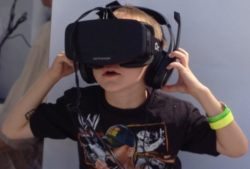Just from watching Engadget’s 6 min. video report about it one can tell “The Last Goodbye” – a 16 min. virtual reality experience that debuted at the Tribeca Film Festival that just wrapped in New York – will have a profound impact on anyone who experiences it. The reporter called it “emotionally harrowing.”

So there are really two central roles in this VR experience: that of Holocaust survivor Pinchas Gutter, who was 11 years old when he was literally shipped to Majdanek, then an extermination camp in Germany-occupied Poland, and that of empathy. Because clearly – based on the thoughtful video report by Engadget reporter Devindra Hardawar – the project is truly all about both. The participant is walking into Gutter’s horrific experience as a child and spending that time with him now, which is beyond extraordinary. Part of it is virtually, immersively, being in – walking around in – the camp with Gutter as he points out what happened in specific locations. “We wanted to ease people into the walk-around,” one of the producers told Hardawar. You can tell that’s needed.
The experience itself is the first part of experiential learning. The other essential part is the reflecting, the thinking out loud, that the participant does about their experience of it. So there’s a third crucial role (if a production is to become a teaching tool) – that of the facilitator or teacher and others external to the experience who are bringing empathy to the overall experience (in and after the virtual part).
Empathy around the VR experience too
So further thought needs to go into empathy’s role. Clearly, based on Engadget’s report, it was central to the project and the producers’ intent. They wanted to be sure the production, the art and the technology, was faithful to the story and the space, they said. In teaching with a tool like this, we’d want nothing less than the level of integrity they’re asserting, right? That’s baseline.
Then there’s the empathy around a teaching tool like this – the kind that supports the participant, especially a child. The producers said they’re not sure what’s next – museums, classrooms, etc. They “want to be able to release it to everyone who has VR headsets.” But maybe it’s not ideally a solitary experience for a child, right? What if it gets into the hands of a child who’s not ready for this “emotionally harrowing” experience? It could be that VR like this needs to be in classrooms and other communities of guided practice, where there are caring adults who know what the children in their care can handle – and who can hold discussions afterwards that give participants context and even emotional support where the experience triggers strong negative emotions.
Related links
- An award-winning empathy teaching tool available to parents and educators right now is Gifts from the Enemy, the true story of Alter Wiener, a teen survivor of five Nazi concentration camps. Writing for children 8-12, award-winning author Trudy Ludwig tells of how “an unexpected person demonstrated moral courage in repeated acts of kindness” toward Alter. As described in Ludwig’s site, the book aims to show “how acts of social justice and kindness can change lives.”
- “Four big trends in virtual reality on display at the Tribeca Film Festival” at Forbes.com
- “How virtual reality can be used to fight prejudice and racism in society” at UploadVR.com